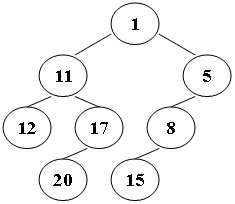Suppose that all the keys in a binary tree are distinct positive integers. A unique binary tree can be determined by a given pair of postorder and inorder traversal sequences. And it is a simple standard routine to print the numbers in level-order. However, if you think the problem is too simple, then you are too naive. This time you are supposed to print the numbers in "zigzagging order" -- that is, starting from the root, print the numbers level-by-level, alternating between left to right and right to left. For example, for the following tree you must output: 1 11 5 8 17 12 20 15.

Input Specification:
Each input file contains one test case. For each case, the first line gives a positive integer N (≤30), the total number of nodes in the binary tree. The second line gives the inorder sequence and the third line gives the postorder sequence. All the numbers in a line are separated by a space.
Output Specification:
For each test case, print the zigzagging sequence of the tree in a line. All the numbers in a line must be separated by exactly one space, and there must be no extra space at the end of the line.
Sample Input:
8
12 11 20 17 1 15 8 5
12 20 17 11 15 8 5 1
Sample Output:
1 11 5 8 17 12 20 15
solution:
#include<bits/stdc++.h>
using namespace std;
#define endl '\n'
typedef long long ll;
typedef struct node *tree;
struct node
{
int val;
tree left,right;
};
vector<int>ans;
const int maxn=1e5+5;
int n;
int in[maxn],post[maxn];
vector<vector<int> >ret;
void input()
{
cin>>n;
for(int i=0;i<n;i++)cin>>in[i];
for(int i=0;i<n;i++)cin>>post[i];
}
tree build(int in[],int post[],int n)
{
if(!n)return NULL;
tree root=new node;
root->val=post[n-1];
root->left=root->right=NULL;
int i;
for(i=0;i<n;i++)
{
if(in[i]==post[n-1])break;
}
root->left=build(in,post,i);
root->right=build(in+i+1,post+i,n-1-i);
return root;
}
void layerorder(tree root)
{
if(root==NULL)return;
queue<tree>q;
q.push(root);
while(!q.empty())
{
int cnt=q.size();
vector<int>tmp;
for(int i=0;i<cnt;i++)
{
tree u=q.front();q.pop();
tmp.push_back(u->val);
if(u->left)q.push(u->left);
if(u->right)q.push(u->right);
}
ret.push_back(tmp);
}
}
void output()
{
for(int i=0;i<ret.size();i++)
{
/*
for(int j=0;j<ret[i].size();j++)
{
cout<<ret[i][j]<<' ';
}
cout<<endl;
*/
if(i%2==0)
{
for(int j=ret[i].size()-1;j>=0;j--)
{
ans.push_back(ret[i][j]);
}
}
else
{
for(int j=0;j<ret[i].size();j++)
{
ans.push_back(ret[i][j]);
}
}
}
for(int i=0;i<ans.size();i++)
{
if(i)cout<<' ';
cout<<ans[i];
}
}
int main()
{
input();
tree root=build(in,post,n);
layerorder(root);
output();
}
总结:根据中序后序建树,然后层序遍历




















 612
612

 被折叠的 条评论
为什么被折叠?
被折叠的 条评论
为什么被折叠?








